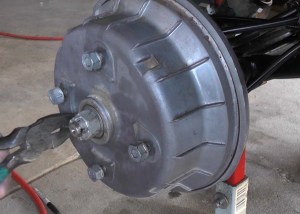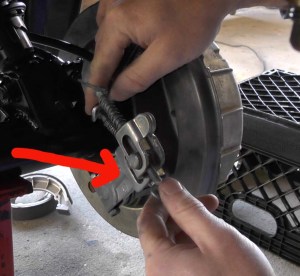 The Afterburn atv tire is a 6 ply Radial sold by GBC and manufactured in Indonesia. GBC has been making off-road ATV tires for many years now and hits include the long standing Dirt Devil. Watch Our Video Review. Recently we had the opportunity to really push the limits of the Afterburn tire mounted on a solid rear axle Brute Force 650. Once mounted and trail riding you'll quickly discover that these tires ride very comfortably, much smoother than some of the biased constructed tires we've tested in the past. Climbing hills with the Afterburn is effortless, they grip well and allow just a bit of spin out so you can keep in the throttle. One can easily spin around in a doughnut if the situation allows and come back into traction as you release the throttle. They handle moderate jumps well and land predictably. Rocks and hard pack are where these tires really shine and chew up the terrain without effort. They also handle well at high speeds and braking is predictable. We are big fans of the all around atv tire and these perform about as well as anything we've tested, including the Bighorn 2.0 by Maxxis. In conclusion we'd say the Afterburn ATV Tire is an incredible choice for a ATV Tire if you're looking for something that is just an all around performer with incredible ride quality.
The Afterburn atv tire is a 6 ply Radial sold by GBC and manufactured in Indonesia. GBC has been making off-road ATV tires for many years now and hits include the long standing Dirt Devil. Watch Our Video Review. Recently we had the opportunity to really push the limits of the Afterburn tire mounted on a solid rear axle Brute Force 650. Once mounted and trail riding you'll quickly discover that these tires ride very comfortably, much smoother than some of the biased constructed tires we've tested in the past. Climbing hills with the Afterburn is effortless, they grip well and allow just a bit of spin out so you can keep in the throttle. One can easily spin around in a doughnut if the situation allows and come back into traction as you release the throttle. They handle moderate jumps well and land predictably. Rocks and hard pack are where these tires really shine and chew up the terrain without effort. They also handle well at high speeds and braking is predictable. We are big fans of the all around atv tire and these perform about as well as anything we've tested, including the Bighorn 2.0 by Maxxis. In conclusion we'd say the Afterburn ATV Tire is an incredible choice for a ATV Tire if you're looking for something that is just an all around performer with incredible ride quality.
The
Afterburn from GBC Tires is an extraordinarily performing radial ATV
tire with unmatched traction on mixed and hard packed terrain.
The semi-aggressive directional tread design promotes superior straight line control and high speed cornering capability.
The lugs are widely spaced to promote traction and cleanout in wet conditions. The 6-ply construction and reinforced carcass design ensure a smooth ride and predictable steering, whether on hard-pack or mixed terrain.
- See more at: http://www.atvtiresbarn.com/gbc-afterburn-atv-tires.html#sthash.ozKmSeiY.dpuf
The semi-aggressive directional tread design promotes superior straight line control and high speed cornering capability.
The lugs are widely spaced to promote traction and cleanout in wet conditions. The 6-ply construction and reinforced carcass design ensure a smooth ride and predictable steering, whether on hard-pack or mixed terrain.
- See more at: http://www.atvtiresbarn.com/gbc-afterburn-atv-tires.html#sthash.ozKmSeiY.dpuf
The
Afterburn from GBC Tires is an extraordinarily performing radial ATV
tire with unmatched traction on mixed and hard packed terrain.
The semi-aggressive directional tread design promotes superior straight line control and high speed cornering capability.
The lugs are widely spaced to promote traction and cleanout in wet conditions. The 6-ply construction and reinforced carcass design ensure a smooth ride and predictable steering, whether on hard-pack or mixed terrain.
- See more at: http://www.atvtiresbarn.com/gbc-afterburn-atv-tires.html#sthash.ozKmSeiY.dpuf
The semi-aggressive directional tread design promotes superior straight line control and high speed cornering capability.
The lugs are widely spaced to promote traction and cleanout in wet conditions. The 6-ply construction and reinforced carcass design ensure a smooth ride and predictable steering, whether on hard-pack or mixed terrain.
- See more at: http://www.atvtiresbarn.com/gbc-afterburn-atv-tires.html#sthash.ozKmSeiY.dpuf









